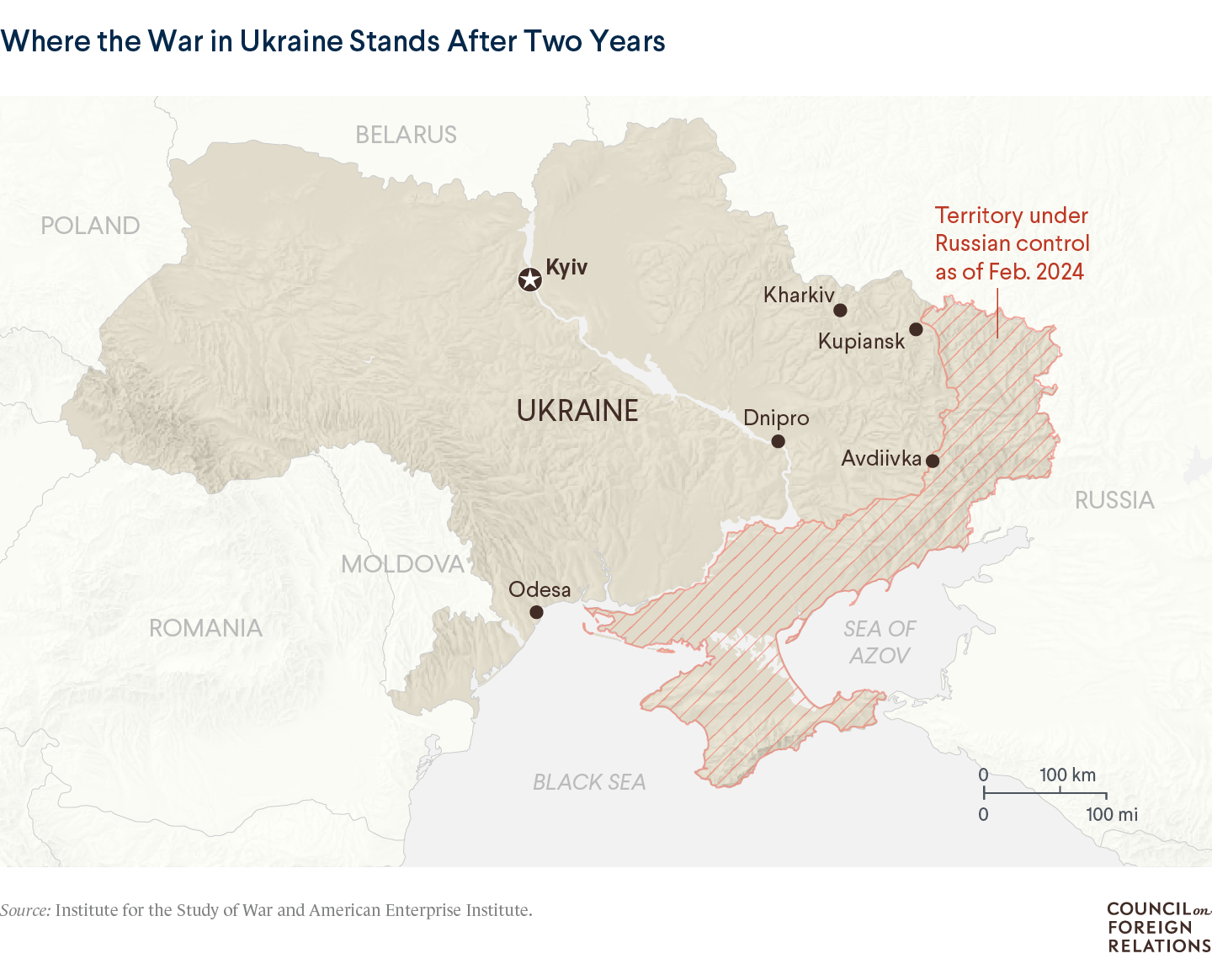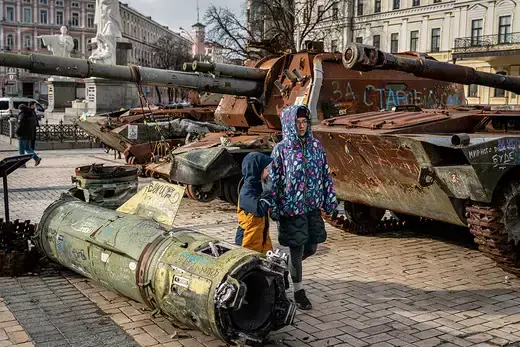Max Boot
 After spending a week in Ukraine in early February, I found that morale has sagged since the last time I was there, in May 2023, but that it still remains high. A regional official from Donetsk province summed up the national mood in a meeting with our American delegation (assembled by the UN High Commissioner for Refugees): “We are tired but not exhausted.”
After spending a week in Ukraine in early February, I found that morale has sagged since the last time I was there, in May 2023, but that it still remains high. A regional official from Donetsk province summed up the national mood in a meeting with our American delegation (assembled by the UN High Commissioner for Refugees): “We are tired but not exhausted.”In public opinion surveys, the number of Ukrainians who express support for making territorial concessions to end the war has roughly doubled, rising from 10 percent in May 2023 (before the start of the big Ukrainian counteroffensive) to 19 percent in December (after its failure). But the vast majority of Ukrainians still want to fight until all occupied Ukrainian territory (about 20 percent of the total) is liberated from Russian control.
While the war has taken a heavy toll on Ukraine’s people and its economy, the country continues to function with a surprising degree of normalcy outside of the front-line areas. We visited major cities including Odesa, Dnipro, and Kyiv, and found all of them crowded and bustling despite regular air raids; Ukrainian air defenses intercept most of Russia’s drones and missiles. Even Kharkiv, Ukraine’s second-largest city, continues to function despite facing heavier Russian bombardment because it is only twenty miles (thirty-two kilometers) from the Russian border. Most Ukrainians have gotten used to the war and are carrying on as best they can. Surrender isn’t an option. “People are traumatized, but we don’t have a choice,” Deputy Foreign Minister Iryna Borovets told us while an air raid siren wailed. “If the Russians win, there would be genocide.”
Despite the strains, Ukraine has had surprising success against the Russian navy in the Black Sea. Now that Ukraine has a new military commander, will there be a change in tactics?
Ukraine’s unheralded success in the Black Sea is a testament to its ingenuity in the face of seemingly insurmountable odds. Ukraine has defeated Russia’s Black Sea fleet without having a navy of its own. Ukraine has relied on sea drones, missiles, and commando raids to push the Russian navy out of its historic anchorage at Sevastopol and reopen the Black Sea for Ukrainian grain exports. On Wednesday, the Ukrainian military reported that it had sunk yet another Russian warship, thereby putting a third of the Black Sea fleet out of action. As a result, exports at Odesa’s three ports are almost back to prewar levels.
Ukraine’s success at sea points to the importance of utilizing asymmetric tactics against Russia rather than frontal assaults such as last year’s failed counteroffensive, which led to the replacement of General Valerii Zaluzhny as Ukraine’s military commander. Under Zaluzhny’s replacement, General Oleksandr Syrskyi, Ukraine is shifting to a defensive strategy along the front line. Provided that Ukrainian troops have sufficient ammunition—which is far from certain given that Republicans in the U.S. House of Representatives continue to block further U.S. aid—they should be able to prevent any major Russian breakthroughs. Meanwhile, Ukraine can use long-range strike platforms, including drones and missiles, to interdict Russian supply lines and target Russian bases in Crimea, making it hard for Russia to maintain forces at the front. The arrival of F-16 fighter jets, probably by this summer, will greatly enhance Ukraine’s long-range strike capacity, but Kyiv will also need more cruise missiles from Europe and the United States and longer-range Army Tactical Missile Systems (ATACMS). If Ukraine succeeds in its long-range strike strategy, that could create the conditions for a more successful counteroffensive in 2025.
What would happen if the United States is unable to supply Ukraine with further military aid at this juncture?
A U.S. failure to aid Ukraine would be an unmitigated catastrophe for Ukraine, Europe, and the United States. The most immediate effects would probably be critical shortages of artillery ammunition, which is already evident at the front, and of air-defense ammunition. If Ukrainian troops don’t have any ammunition to hold back Russian assaults, the Russians could breach the Ukrainian lines. Already, on Saturday, Syrski announced that Ukrainian troops were withdrawing from the city of Avdiivka in Donetsk province, thereby handing Russian forces their biggest victory since the fall of Bakhmut in May 2022. Even more alarming would be the loss of Kupiansk in Kharkiv province, because that would allow Russian troops to besiege Ukraine’s second-largest city once again.

Ukrainian people walk along destroyed Russian vehicles in Kyiv.
There is also the worrisome prospect that, if Ukraine runs low on air-defense ammunition, Russia will be able to inflict much greater death and destruction on Ukraine’s cities. That would set back Ukraine’s economic recovery and likely lead to another major exodus of refugees. (Already, 6.3 million Ukrainians have fled the country, and another 3.7 million are internally displaced.) Kyiv is not going to fall this year, but make no mistake: without U.S. aid, Ukraine is likely to lose the war.
What should Ukraine’s Western allies be focusing on in the months ahead?
It is imperative for the United States and Europe to come up with a viable, long-term strategy to support Ukraine. This is not just a matter of altruism but of self-interest: if Russia wins in Ukraine, the other former parts of the Soviet Empire (including North Atlantic Treaty Organization (NATO) members Poland and the Baltic republics) are likely to be next on Russian President Vladimir Putin’s target list. That, in turn, could embroil the United States in war—provided, of course, that Donald Trump is not the U.S. president at the time and hasn’t already undermined or destroyed NATO.
Implementing a long-term strategy would mean accelerating Ukraine’s accession to the European Union and signing bilateral agreements to provide Ukraine with continuing military and economic aid. Part of the Western aid should go to helping Ukraine build up its own defense industry, so that it can become more self-sufficient in armaments. This will not be a cheap commitment, but it is much cheaper than the alternative of letting Russia win and thereby signaling to other potential aggressors (e.g., China) that they can attack their neighbors with impunity.
What are the prospects for establishing any process with Russia that could lead to an end to the war?
There is zero chance right now of Putin ending the war. Why should he when he sees U.S. support for Ukraine wavering? The Russian tyrant surely hopes that Trump will win the U.S. presidency in November and then cut off Ukraine while dissolving NATO. It is vitally important for the United States to continue supporting Ukraine to show Putin he cannot prevail. (Sending $300 billion in frozen Russian assets to Ukraine would certainly get the Kremlin’s attention.) That, in turn, could eventually lead to a negotiated peace in which Russia retains some of its illegally occupied territory but Ukraine receives security guarantees from the West (possibly in the form of future NATO membership) that ensure its sovereignty and survival.
No comments:
Post a Comment